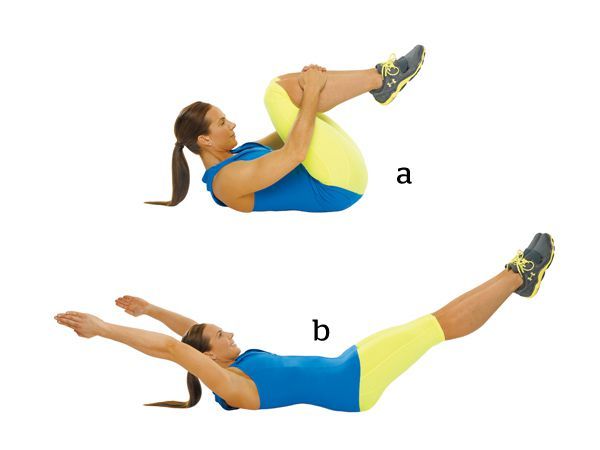21 de October de 2025
V-Ups: Exercise Guide, Tips and Benefits
V-ups are a challenging core exercise that combine elements of a sit-up and a leg raise, making them one of the most effective movements for building midsection strength and control. They require coordination, balance, and mobility, making them a valuable addition to Strength and Conditioning programs for athletes who need strong, stable cores to transfer power efficiently.
What Are V-Ups?
V-ups are a dynamic abdominal exercise performed by lifting both the upper and lower body simultaneously into a “V” shape. By requiring the torso and legs to move together, this exercise challenges the rectus abdominis, obliques, hip flexors, and stabilizers.
Unlike static holds such as planks, V-ups are a more advanced progression because they involve movement, balance, and flexibility. Coaches often prescribe them to develop explosive torso strength and improve athletic performance in sports that demand core stability and rotational control.
How to Do V-Ups Properly
- Starting Position: Lie flat on your back with legs extended and arms stretched overhead.
- Engage the Core: Brace your abs and keep your lower back pressed against the floor.
- Lift Simultaneously: Raise your legs and upper body at the same time, reaching your hands toward your feet.
- Peak Position: Form a “V” shape at the top, balancing on your glutes. Keep legs as straight as possible.
- Controlled Descent: Lower back down slowly, avoiding momentum.
- Repetitions: Beginners can aim for 8–10 reps, while advanced athletes may target 15–20 reps per set.
👉 Coaching tip: If the athlete struggles to keep legs straight, allow a slight bend at the knees while reinforcing abdominal engagement.

Muscles Worked by V-Ups
- Rectus abdominis (front abs)
- Obliques (side abs, stability)
- Hip flexors (leg lift)
- Lower back stabilizers (spinal support)
- Shoulders and arms (secondary, for balance and reach)
Benefits of V-Ups
- Core Power and Endurance: V-ups require both strength and stamina, developing a resilient torso.
- Athletic Transfer: Improves performance in sports requiring explosive hip flexion and trunk stability, such as sprinting, soccer, and gymnastics.
- Full-Range Engagement: Trains abs through a larger range of motion than crunches or planks.
- Coordination and Mobility: Demands balance and flexibility, enhancing movement control.
- Progression Potential: Can be scaled with weights (medicine ball or dumbbell reach) or tempo variations.
- Conditioning: Adds intensity to circuits and high-rep sets, supporting endurance under fatigue.
V-ups can also be monitored within velocity zones or used as part of a load-velocity profile to measure performance quality. For recovery, coaches should track fatigue and ensure athletes maintain technical control.

Common Mistakes to Avoid
- Using momentum: Swinging arms or legs reduces abdominal engagement.
- Rounded lower back: Losing contact with the floor strains the spine.
- Bent arms or legs: Shortens the range of motion and lowers intensity.
- Holding breath: Proper breathing helps sustain tension and performance.
- Rushing reps: Speed sacrifices form; controlled execution is more effective.
Variations of V-Ups
- Tuck-Ups: Bend knees toward chest instead of keeping legs straight (beginner-friendly).
- Weighted V-Ups: Hold a dumbbell or medicine ball for added resistance.
- Single-Leg V-Ups: Alternate raising one leg at a time.
- Twisting V-Ups: Add rotation to target the obliques.
- Tempo V-Ups: Slow eccentric (lowering phase) for more time under tension.
- Hollow Hold to V-Up: Transition between static and dynamic positions for endurance.
How to Include V-Ups in Your S&C Workout
- Warm-Up Core Activation: Short sets to engage the torso before heavy lifts.
- Accessory Core Work: Pair with compound exercises to reinforce stability.
- High-Rep Conditioning: Include V-ups in circuits, AMRAPs, or intervals.
- Testing Tool: Use max-rep sets as benchmarks for core endurance across athletes.
- Sport-Specific Training: Beneficial for sports that demand trunk stiffness and explosive hip flexion (e.g., sprinting, martial arts, gymnastics).
- Fatigue Monitoring: Use V-ups within structured Strength and Conditioning programs to assess control when athletes are tired.
FAQs About V-Ups
What are V-Ups good for?
V-ups are excellent for building core strength, improving coordination, and increasing mobility. They also provide a functional carryover to sports that rely on trunk stability and explosive hip action.
How to do V-Ups for beginners?
Beginners can start with tuck-ups (knees bent) or partial V-ups, focusing on controlled movement. Using a stability ball or performing single-leg V-ups can also reduce difficulty while maintaining proper form.
How difficult are V-Ups?
V-ups are considered an advanced ab exercise because they require strength, flexibility, and balance. Many athletes find them more challenging than planks or crunches due to the combined upper- and lower-body movement.
Are V-Ups better than crunches?
Yes, V-ups generally engage more muscles and use a greater range of motion than crunches. While crunches isolate the rectus abdominis, V-ups recruit hip flexors, obliques, and stabilizers for a more complete core workout.
Will V-Ups give you abs?
V-ups help strengthen and define abdominal muscles, but visible abs also require fat reduction through proper nutrition and overall training. They build muscle endurance rather than mass.
Do V-Ups work chest?
The chest is not a primary target in V-ups. However, the arms and shoulders assist in balance and reaching, which provides secondary activation.
Do V-Ups help with weight loss?
V-ups alone won’t cause fat loss, but they increase calorie burn as part of a complete program. Weight loss depends on maintaining a caloric deficit supported by balanced training and nutrition.
